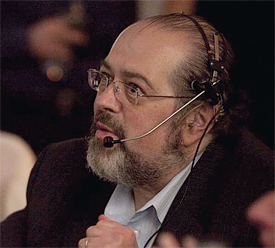Immediate Intimacy
“The first images you get from breaking news stories are now almost always from people with cellphones or people with their own cameras, whether that’s the South Pacific tsunami or the plane crash on the Hudson,” said Bohrman, a veteran of CNN. “Everyone out there is now the first journalist on the scene. Most news organizations already have or are figuring out how to quickly incorporate that into their news coverage. Everyone is trying to figure out how to take advantage of the fact that everyone out there is a reporter.”

A reporter captures the Super Bowl XLV post-game festivities with LiveU’s backpack.THE NEW WAVE
In the United States, just having an iPhone on hand can be enough to do the trick, especially when it comes to shooting quick footage for the Web. But when it comes to broadcasting live coverage from a breaking news scene, many reporters and producers now are armed with portable transmission technology that allows them to transmit live video even under challenging conditions.
Companies such as LiveU or VidOvation offer products that uplink to local cellular, landline broadband or satellite.
LiveU’s LU60 product series is an “ENG truck in a backpack,” said Ariel Galinsky, LiveU’s vice president of business and corporate development. “The value proposition to TV news organizations is that we enable more live content with less capital investment and less operational headaches. Our backpack is an alternative to traditional microwave or satellite tools.”
LiveU’s backpack, which can be connected to almost any camera, aggregates bandwidth from up to 14 local cellular providers to transmit 1080i HD broadcast-quality streaming video from site to studio. For example, if a reporter was streaming live stand-ups from Cairo during the Egyptian revolution, the LU60 would be able to find available cellular networks until it had enough bandwidth to send the live video.
Similarly, VidOvation offers its StreamCell “ENG TV Truck in a box,” which transmits over cellular, landline broadband or satellite. StreamCell connects directly to a camera, and allows the user to select which streaming service to use depending on availability. These portable solutions are so robust and reliable that TV news networks are increasingly going with them over ENG trucks, said Jim Jachetta, president of VidOvation.
“We have had major networks ask to replace their ENG and SNG fleet with cellular-based portable and backpack video back-haul devices,” he said. “The current cellular networks do not offer reliable bandwidth in every location, however, so we may have backpacks replacing a $2 million ENG truck at some point but we’re not there yet.”
Back in the studio, journalists also are availing themselves of technology to better explain and illustrate the news.

David Bohrman, Current TV Bohrman, who brought the “magic wall” to CNN, is constantly looking for ways to innovate story-telling. CNN was one of the first news organizations to recognize that Twitter is now the “very front line detector for something going on,” Bohrman said. “If there’s an earthquake, it will be on Twitter five, 10 or 15 minutes before the [Associated Press]. Twitter is like the new ticker tape.”
CRIMSON HEXAGON
Borhman’s latest find is Crimson Hexagon, a technology created by a Harvard professor that applies an algorithm to social media—such as Twitter, Facebook and blogs—to find out what the masses think about almost any given subject.
“Just about every other technology out there is only capable of giving you a sense of positive and negative sentiment around specific keywords,” said Wayne St. Amand, Crimson Hexagon’s vice president of marketing. “Our technology enables you to uncover the why, and what the specific themes are inside the conversation. It’s extremely valuable for a news organization to uncover the drivers behind these opinions.”
For example, if a news organization was tracking opinion about former presidential candidate Herman Cain, whose candidacy was swallowed by a string of sexual scandals, it could use Crimson Hexagon to learn that the predominant opinions about Cain were everything from “he should stay in the race,” to “he should drop out,” to “he should be prosecuted.”
“It comes up with distinct buckets of feeling,” St. Amand said. “It’s not opinion polling, but it’s an interesting way of gauging opinion.”
Technology’s best pay-off, when it comes to news, is its immediate intimacy.
“If technology is not used well, it depersonalizes the news and gets in the way,” Bohrman said. “But when you have cellphone pictures coming out of Iran or Syria, countries we aren’t even allowed into, that makes the world incredibly small.”
The professional video industry's #1 source for news, trends and product and tech information. Sign up below.
